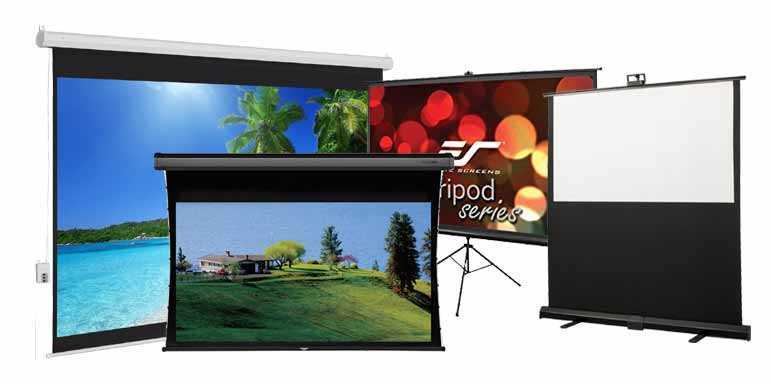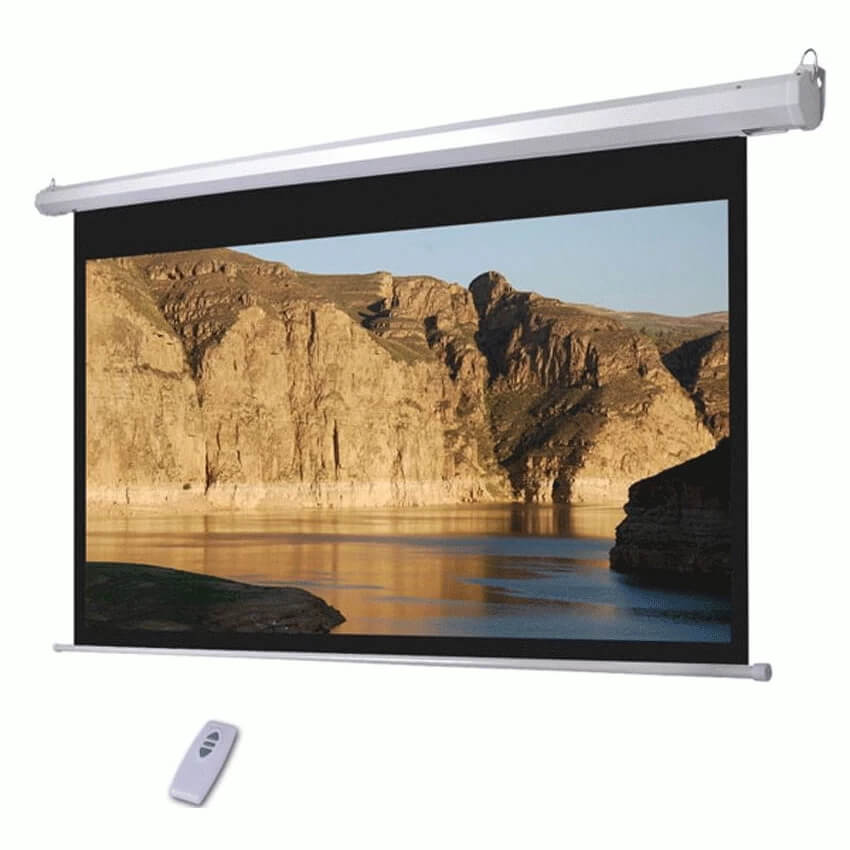Choosing The Right Types of Projector Screen

Using projector screens is a common tool for projection scenarios. The projector screen makes sure image quality is sharper and crispy & most importantly it’s bigger for a hall room. It’s important to choose the right screen type depending on your setup & requirements needs. In this article, you can learn about all types of projector screens & decide on a suitable screen type for your projector. Let’s dive deep into this article.
General Type Projector Screen
There are four general screen types. They are Tripod Screen, Manual Screen, Electric Screen, and Holed Screen.
Tripod Screen: A portable and versatile projection screen, the tripod screen finds common use in presentations, meetings, and home theater setups. Characterized by its tripod stand, it offers stability and easy setup. Additionally, the screen material is typically high-quality, ensuring a clear and vibrant display of projected images or videos. The tripod stand allows for adjustable height, making it adaptable to different venues and presentation scenarios. Its portability and quick assembly make it a popular choice for professionals on the go or individuals looking for a convenient solution for impromptu presentations, movie nights, or gaming. Tripod screens come in various sizes to accommodate different projection needs. Tripod screen providing a flexible and efficient display solution for a range of applications.
Manual Screen: A manual screen is a type of projection screen designed for straightforward and manual operation. In contrast to motorized or electric screens, a manual screen is operated by physically pulling the screen down and locking it into place or retracting it using a manual mechanism. Often a spring-loaded or pull-down system. Users prefer manual screens primarily in situations where they seek a simpler and more cost-effective solution.
Manual screens are available in various sizes and aspect ratios to suit different projection needs. The manual screens have these dimensions: 60” X 60”, 70” X 70”, 84” X 84”, 96” X 96”, 120” X120”. Known for reliability, ease of use, and durability, manual screens are a common choice in classrooms, boardrooms, home theaters, and other environments requiring a consistently dependable projection surface without the need for automated features. Furthermore, the manual operation of these screens makes them a practical choice for users who prioritize simplicity and functionality in their projection setup.
Electric Screen: An electric screen is an advanced and automated solution for projection setups. This type of projection screen is equipped with an electric motor that allows for smooth and convenient operation. Unlike manual screens, electric screens can be controlled using a remote, wall switch, or integration with home automation systems. With just a press of a button, the screen descends or ascends gracefully, providing a seamless and professional display experience. They come in various sizes such as 60” X 60”, 70” X 70”, 84” X 84”, 96” X 96”, 120” X120”.
Holed Screen: A holed screen is a cloth that has some hole in the border to set it in the wall or using any stand. This is the bare minimum for a projector screen. This screen type is very cheap and prices the basic need of throwing projector light.

Home Theatre Type Projector Screen
Home theatre types screens are of two types, ALR screens, and high-contrast screens. ALR screen has two types, one is a fixed frame screen another is floor floor-rising screen. High-contrast screens are also two types, high-contrast grey screens & high contrast silver screens.
ALR Screen: An ALR (Ambient Light Rejecting) screen, whether in a fixed frame or floor-rising configuration, enhances the viewing experience in challenging lighting conditions. Specifically engineered, ALR screens minimize the impact of ambient light. Also color accuracy, and visibility even in brightly lit spaces.
Fixed Frame ALR Screen: A fixed frame ALR screen is a permanently mounted projection screen that features a specialized material designed to reject ambient light. Fixed frame screens are ideal for home theaters, conference rooms, or any space where a dedicated projection setup is available.
Floor Rising ALR Screen: A floor-rising ALR screen seamlessly integrates ambient light rejection benefits with a practical, motorized floor-rising mechanism. The floor-rising design allows the screen to hide within a floor housing unit and rise up smoothly when needed.
Users prefer both fixed frame and floor-rising ALR screens because they excel at maintaining image quality in challenging lighting conditions. It makes them suitable for applications ranging from home entertainment systems to professional presentations in well-lit rooms.
High Contrast (Grey/Silver): A high-contrast grey or silver screen is a specialized projection screen designed to optimize image clarity and contrast in various lighting conditions. Unlike traditional white screens, high-contrast screens incorporate a grey or silver tint to enhance the perceived contrast ratio. More accurately saying is, it performs better in environments with ambient light.
High Contrast Grey Screen: A high-contrast grey screen features a grey surface that helps improve black levels and overall contrast. This is particularly beneficial in home theaters or presentation settings where controlling ambient light is a challenge. The grey tint absorbs ambient light, preventing it from washing out the darker areas of the projected image. This results in sharper details and a more immersive viewing experience.
High Contrast Silver Screen: A high-contrast silver screen takes the concept further by incorporating a reflective silver coating. This screen is suitable for environments with high levels of light. The silver coating reflects more of the projector’s light back toward the audience, enhancing the overall visibility of the content.
High-contrast grey and silver screens are popular for home theaters, conference rooms, and venues where achieving optimal image quality in challenging lighting conditions is essential.
Conclusion
A projector screen serves as a fundamental component in creating a captivating and immersive visual experience. Whether it’s for home theaters, presentations, or large-scale events, the right projector screen can significantly impact the quality of the displayed content. Manual screens offer simplicity and cost-effectiveness, while electric screens provide automation and convenience. Specialized screens like ALR (Ambient Light Rejecting) and high-contrast (grey/silver) cater to specific needs. They optimizing image quality in various lighting conditions. The choice of a projector screen ultimately depends on the intended use, space, and desired visual outcomes.



